My Career as a Mineral Physicist at Stony Brook: 1976–2019
Abstract
1. Introduction
2. Before Stony Brook
3. Start of my Career at Stony Brook (1976 to 1983)
4. Establishment Stony Brook High Pressure Laboratory and Evolution to CHiPR and COMPRES: 1984 to 2019
5. Bob as an Administrator at Stony Brook
6. For Additional Details
Funding
Acknowledgments
Conflicts of Interest
Appendix A
Appendix A.1. GEO 556: Solid-State Geophysics (Originally ESS 556)
- Sp77: Doug Anderson, Elizabeth Hauser, and Robin Reichlin
- —listed as GEO 607.
- Audits: Alan Kafka, Hubert King, Louise Levien, Michael Vaughan.
- Sp78: Jay Bass, Ben Burton, Paula Davidson, Barbara Leitner, Susan Narbut.
- First time listed as ESS 556.
- F79: Andy Au, Jay Bass, Ben Burton, Ann Singer.
- F82: Hwai-kuo Chen, John Kandelin, Tom Ruubel, Michael Simpson, Ann Sirinides.
- Sp85: Gabriel Gwanmesia, Virginia Haniford, Jaidong Ko, Xing Liu, Amir Yeganeh-haeri, Jianzhong Zhang.
- F87: Ren Lu, George Moussouris, Rosemary Pacalo, Kim Pacanovsky, Anne Remsberg, Yanbin Wang.
- Audit: Gabriel Gwanmesia.
- F89: Yves Bertran, Yuan Liu, Yue Meng, Woosun Yang, Yusheng Zhao.
- F91: Jishan Jin, Baosheng Li, Wenlu Zhu, Yong Zou.
- F93: Reggie Minault, Bingming Shen-tu, Yegor Sinelnikov, Xiang Xia.
- F95: Tony Cooke, Lucy Flesch, Rui Li, Jun Liu, Yujin Wu, Hui Zhao.
- Audit: Frédéric Béjina.
- F97: Corne Kreemer, Haibin Su
- Audits: Ganglin Chen, Jiuhua Chen, Hiroki Kagi, Jianzhong Zhang.
- SP00: Stan Adler, Kenneth Darling, Elliot Klein, Li Li, Laura Rossier, Veronika Vajdova
- F11: Yu Chen, Yuan-yuan Liu, Guangrui.Qian, Gina Scherbenko, Terry-Ann Suer.
- Audit: Matt Jacobsen.
- F13: Ting Chen, Adairè Heady, Xintong Qi, Ashley Thompson, Melissa Sims, XuebingWang.
- Audits: Xuefei Li, Yongtao Zou.
Appendix A.2. Theses Supervised by Bob Liebermann at ANU and SBU
Appendix A.2.1. Australian National University—Research School of Earth Sciences
- Ian Jackson (1976)—Ph.D.
- Subject: Phase equilibria and elastic properties in silicate analogue systems: studies of melting and polymorphic phase transformations.
- Leonie Jones (1976)—Ph.D.
- Subject: High-temperature elastic properties of fluoride and oxide analogues.
- State University of New York at Stony Brook:
- Department of Earth and Space Sciences (1976–1997)
- Department of Geosciences (1997–2019)
- Barbara J. Leitner (1979)—M.S.
- Subject: Elasticity of Single Crystal Pyrope
- Ellyn A. Schlesinger (1979)—M.S.
- Subject: A Seismic Noise Survey of Long Island, New York
- Susan M. Narbut (1979)—M.S.
- Subject: Phase equilibria of the disproportionation reaction Ca2SnO4 (strontium plumbate) CaSnO3 (perovskite) plus CaO (rocksalt)
- Peter J. Lellis (1980)—B.S. Honors
- Subject: Isostructural systematics of elasticity in silicate minerals
- Ann E. Sirinides (l983)—M.S.
- Subject: Elastic Properties of two-phase Aggregates
- Richard J. Wilkinson (l983)—M.S.
- Subject: The Long Island Sound Earthquake of October 21, l981: Location, Focal Mechanism, Intensity Survey
- Thomas Ruubel (l984)—M.S.
- Subject: Laboratory measurements of velocities in rocks from the Ramapo fault system
- Kirk Maasch (1986)—B.S. Honors
- Subject: Acoustic and static compression experiments on the elastic behavior of hematite.
- Gabriel Gwanmesia (1987)—M.S.
- Subject: Pressure calibration in a girdle-anvil and a DIA-type pressure apparatus at room temperature (25 °C) and high temperature (1000 °C)
Appendix A.2.2. Theses Supervised (cont.)
- Anne R. Remsberg (1990)—Ph.D.
- Subject: A study of the polymorphic phase transformations in Co2SiO4
- Ren Lu (1990)—M.S.
- Subject: Study of kinetic rates of transformation between garnet and perovskite phases of CaGeO3
- Yanbin Wang (1991)—Ph.D
- Subject: Electron microscopy and X-ray diffraction studies on structural phase transitions in MgSiO3 perovskite.
- Gabriel Gwanmesia (1991)—Ph.D
- Subject: High pressure elasticity for the beta and spinel polymorphs of Mg2SiO4 and composition of the transition zone of the Earth’s mantle.
Appendix A.2.3. Yves Bertran at Université Paris XI [Olivier Jaoul]
- Baosheng Li (1993)—M.S.
- Subject: Polycrystalline Stishovite: Hot-pressing and elastic properties
- Baosheng Li (1996)—Ph.D.
- Subject: Ultrasonic Measurements of the Elastic Wave Velocities of Olivine and Beta Polymorphs of Mg2SiO4 at Mantle Transition Zone P and T and Geophysical Implications
- Lucy C. Flesch (1997)—M.S.
- Subject: Sound velocities in polycrystalline MgSiO3-orthopyroxene to 10 GPa at room temperature
- Jun Liu (1997)—M.S.
- Subject: Calorimetry study of the coesite-stishovite transformation and calculation of the phase boundary
- Yegor Sinelnikov (1997)—M.S.
- Subject: Elasticity of CaTiO3-CaSiO3 perovskites
- Joseph A. Cooke (1997)—M.S.
- Subject: Ultrasonic measurements of the elastic wave velocities of Mg3Al2Si3O12 pyrope garnet to 9 GPa at room temperature
- Yegor Sinelnikov (1998)—Ph.D.—Check This Date?
- Subject: Elasticity of MgSiO3-perovskite at high pressure and temperature by ultrasonic interferometry
Appendix A.2.4. Theses Supervised (cont.)
- Jun Liu (2001)—Ph.D.
- Subject: Elasticity of Pyrope-Majorite Garnets at High Pressures and Temperatures and Implications for Geophysics
- Kenneth Darling (2002)—M.S.
- Subject: Ultrasonic Measurements of the Elastic Wave Velocities of Polycrystalline (Mg,Fe) San Carlos Olivine
References
- Liebermann, R.C. The Role of Serendipity in My Career in Mineral Physics: 1968 to 2013. Phys. Earth Planet. Inter. 2014, 228, 307–323. [Google Scholar] [CrossRef]
- Anderson, O.L. Equations of State of Solids for Geophysics and Ceramic Science; Oxford University Press: Oxford, UK, 1995. [Google Scholar]
- Weidner, D.J.; Carleton, H.R. Elasticity of coesite. J. Geophys. Res. 1997, 82, 1334–1346. [Google Scholar] [CrossRef]
- Bass, J.D.; Liebermann, R.C.; Weidner, D.J.; Finch, S.J. Elastic properties from acoustic and volume compression experiments. Phys. Earth Planet. Inter. 1981, 25, 140–158. [Google Scholar] [CrossRef]
- Leitner, B.J.; Weidner, D.J.; Liebermann, R.C. Elasticity of single crystal pyrope and implications for garnet solid solution series. Phys. Earth Planet. Inter. 1980, 22, 111–121. [Google Scholar] [CrossRef]
- Sasaki, S.; Prewitt, C.T.; Liebermann, R.C. The crystal structure of CaGeO3 perovskite and the crystal chemistry of the GdFeO3-type perovskites. Am. Mineral. 1983, 68, 89–98. [Google Scholar]
- Poirier, J.P.; Liebermann, R.C. On the activation volume for creep and its variation with depth in the Earth’s lower mantle. Phys. Earth Planet. Inter. 1984, 35, 283–293. [Google Scholar] [CrossRef]
- Liebermann, R.C.; Maasch, A.K. Acoustic and static compression experiments on the elastic behavior of hematite. J. Geophys. Res. 1986, 91, 4651–4656. [Google Scholar] [CrossRef]
- Liebermann, R.C. Impact of technology on high-pressure geophysics. In The Impact of Technology on Geophysics; a study conducted by the Impact of Technology Panel of the Geophysics Study Committee of the Geophysics Research Board; National Research Council, National Academy of Sciences: Washington, DC, USA, 1979. [Google Scholar]
- Houlier, B.; Jaoul, O.; Abel, F.; Liebermann, R.C. Oxygen and silicon self-diffusion in natural olivine at T = 1300 °C. Phys. Earth Planet. Inter. 1988, 50, 240–250. [Google Scholar] [CrossRef]
- Bertran-Alvarez, Y.; Jaoul, O.; Liebermann, R.C. Fe-Mg interdiffusion in single crystal olivines at very high pressure and controlled oxygen fugacity: Technological advances and initial data at 7 GPa. Phys. Earth Planet. Inter. 1992, 70, 102–118. [Google Scholar] [CrossRef]
- Jaoul, O.; Bertran-Alvarez, Y.; Liebermann, R.C.; Price, G.D. Fe-Mg interdiffusion in olivine up to 9 GPa at T = 600–900 °C. Experimental data and comparison with defect calculations. Phys. Earth Planet. Inter. 1995, 89, 199–218. [Google Scholar] [CrossRef]
- Raterron, P.; Bejina, F.; Doukhan, J.C.; Jaoul, O.; Liebermann, R.C. Olivine/Fe-metal equilibrium under high pressure: An ATEM investigation. Phys. Chem. Miner. 1998, 25, 285–493. [Google Scholar] [CrossRef]
- Béjina, F.; Raterron, P.; Zhang, J.; Jaoul, O.; Liebermann, R.C. Activation volume of silicon diffusion in San Carlos olivine. Geophys. Res. Lett. 1997, 24, 2597–2600. [Google Scholar] [CrossRef]
- Béjina, F.; Jaoul, O.; Liebermann, R.C. Activation volume for Si diffusion in San Carlos olivine: Implications for upper mantle rheology. J. Geophys. Res. 1999, 104, 25529–25542. [Google Scholar] [CrossRef]
- Ingrin, J.; Liebermann, R.C. Deviatoric stress in a girdle-anvil type high pressure apparatus: Effect on the quartz-coesite phase transformation. Phys. Earth Planet. Inter. 1989, 54, 378–385. [Google Scholar] [CrossRef]
- Wang, Y.; Liebermann, R.C.; Boland, J.N. Olivine as an in situ piezometer in high pressure apparatus. Phys. Chem. Miner. 1988, 15, 493–497. [Google Scholar] [CrossRef]
- Guyot, F.; Gwanmesia, G.D.; Liebermann, R.C. An olivine to beta phase transformation mechanism in Mg2SiO4. Geophys. Res. Lett. 1991, 18, 89–92. [Google Scholar] [CrossRef]
- Martinez, I.; Wang, Y.; Guyot, F.; Liebermann, R.C.; Doukhan, J.-C. Microstructures and iron partitioning in (Mg,Fe)SiO3 perovskite-(Mg,Fe)O Magnesiowustite assemblages: An analytical transmission electron microscopy study. J. Geophys Res. 1997, 102, 5265–5280. [Google Scholar] [CrossRef]
- Remsberg, A.R.; Boland, J.N.; Gasparik, T.; Liebermann, R.C. Mechanism of the olivine-spinel transformation in Co2SiO4. Phys. Chem. Miner. 1988, 15, 498–506. [Google Scholar] [CrossRef]
- Wang, Y.; Guyot, F.; Liebermann, R.C. Electron microscopy of (Mg,Fe)SiO3 perovskite: Evidence of structural phase transitions and implications for the lower mantle. J. Geophys. Res. 1992, 97, 12327–12347. [Google Scholar] [CrossRef]
- Gwanmesia, G.D.; Liebermann, R.C. Polycrystals of high-pressure phases of mantle minerals: Hot-pressing and characterization of physical properties. In High Pressure Research: Applications to Earth and Planetary Sciences; Syono, Y., Manghnani, M.H., Eds.; Terra Scientific Publishing Co., Tokyo/American Geophysical Union: Washington, DC, USA, 1992; pp. 117–135. [Google Scholar]
- Gwanmesia, G.D.; Li, B.; Liebermann, R.C. Hot pressing of polycrystals of high pressure phases of mantle minerals in multi-anvil apparatus. PAGEOPH 1993, 141, 467–484. [Google Scholar] [CrossRef]
- Gwanmesia, G.D.; Rigden, S.; Jackson, I.; Liebermann, R.C. Pressure dependence of elastic wave velocity for β-Mg2SiO4 and the composition of the Earth’s mantle. Science 1990, 250, 794–797. [Google Scholar] [CrossRef]
- Rigden, S.M.; Gwanmesia, G.D.; FitzGerald, J.D.; Jackson, I.; Liebermann, R.C. Spinel elasticity and seismic structure of the transition zone of the mantle. Nature 1991, 354, 143–145. [Google Scholar] [CrossRef]
- Rigden, S.M.; Gwanmesia, G.D.; Liebermann, R.C. Elastic wave velocities of a pyrope-majorite garnet to 3 GPa. Phys. Earth Planet. Inter. 1994, 84, 35–44. [Google Scholar] [CrossRef]
- Li, B.; Rigden, S.M.; Liebermann, R.C. Elasticity of stishovite at high pressure. Phys. Earth Planet. Inter. 1996, 96, 113–127. [Google Scholar] [CrossRef]
- Antao, S.M.; Jackson, I.; Li, B.; Kung, J.; Chen, J.; Hassan, I.; Liebermann, R.C.; Parise, J.B. High-temperature elasticity of magnesioferrite spinel. Phys. Chem. Miner. 2007, 34, 345–350. [Google Scholar] [CrossRef]
- Kung, J.; Jackson, I.; Liebermann, R.C. High-temperature elasticity of polycrystalline orthoenstatite (MgSiO3). Am. Mineral. 2011, 96, 577–585. [Google Scholar] [CrossRef]
- Li, B.; Jackson, I.; Gasparik, T.; Liebermann, R.C. Elastic wave velocity measurement in multi-anvil apparatus to 110 GPa using ultrasonic interferometry. Phys. Earth Planet. Inter. 1996, 98, 79–91. [Google Scholar] [CrossRef]
- Chen, G.; Cooke, J.A., Jr.; Gwanmesia, G.D.; Liebermann, R.C. Elastic Wave Velocities of Mg3Al2Si3O12-Pyrope Garnet to 10 GPa. Am. Mineral. 1999, 84, 384–388. [Google Scholar] [CrossRef]
- Flesch, L.C.; Li, B.; Liebermann, R.C. Sound velocities in polycrystalline MgSiO3-orthopyroxene to 10 GPa at room temperature. Am. Mineral. 1998, 83, 444–450. [Google Scholar] [CrossRef]
- Sinelnikov, Y.D.; Chen, G.; Neuville, D.R.; Liebermann, R.C. Ultrasonic shear velocities of MgSiO3-perovskite at high pressure and temperature and lower mantle composition. Science 1998, 281, 677–679. [Google Scholar] [CrossRef]
- Liu, J.; Chen, G.; Gwanmesia, G.D.; Liebermann, R.C. Elastic wave velocities of pyrope-majorite garnets (Py62Mj38 and Py50Mj50) to 9 GPa. Phys. Earth Planet. Inter. 2000, 120, 153–163. [Google Scholar] [CrossRef]
- Darling, K.L.; Gwanmesia, G.D.; Kung, J.; Li, B.; Liebermann, R.C. Ultrasonic measurements of the sound velocities in polycrystalline San Carlos olivine in multi-anvil, high-pressure apparatus. Phys. Earth Planet. Inter. 2004, 143–144, 19–31. [Google Scholar] [CrossRef]
- Chen, G.; Li, B.; Liebermann, R.C. Selected elastic moduli of single crystal olivines from ultrasonic experiments to mantle pressures. Science 1996, 272, 979–980. [Google Scholar] [CrossRef] [PubMed]
- Decremps, F.; Li, B.; Liebermann, R.C. Single-crystal elasticity of ZnO at high pressure. In Proceedings of the International Conference on High Pressure Science and Technology (AIRAPT-17), Honolulu, HI, USA, 25–30 July 1999; Volume 2, pp. 810–813. [Google Scholar]
- Decremps, F.; Zhang, J.; Li, B.; Liebermann, R.C. Pressure-induced softening of shear modes in ZnO. Phys. Rev. B 2001, 63, 224105. [Google Scholar] [CrossRef]
- Kung, J.; Li, B.; Weidner, D.J.; Zhang, J.; Liebermann, R.C. Elasticity of (Mg0.83 Fe0.17)O ferropericlase at high pressure: Ultrasonic measurements in conjunction with X-radiation techniques. Earth Planet. Sci. Lett. 2002, 203, 557–566. [Google Scholar] [CrossRef]
- Gwanmesia, G.D.; Zhang, J.; Darling, K.; Kung, J.; Li, B.; Wang, L.; Neuville, D.; Liebermann, R.C. Elasticity of polycrystalline pyrope (Mg3Al2Si3O12) to 9 GPa and 1000 °C. Phys Earth Planet. Inter. 2006, 155, 179–190. [Google Scholar] [CrossRef]
- Liebermann, R.C.; Chen, G.; Li, B.; Gwanmesia, G.D.; Chen, J.; Vaughan, M.T.; Weidner, D.J. Sound Velocity Measurements in Oxides and Silicates at Simulatneous High Pressures and Temperatures using Ultrasonic Techniques in Multi-Anvil Apparatus in Conjunction with Synchrotron X-radiation Determination of Equation of State. Rev. High Press. Sci. Technol. 1998, 7, 75–78. [Google Scholar] [CrossRef]
- Li, B.; Liebermann, R.C. Indoor seismology by probing the Earth’s interior by using sound velocity measurements at high pressures and temperatures. Proc. Natl. Acad. Sci. USA 2007, 104, 9145–9150. [Google Scholar] [CrossRef]
- Li, B.; Liebermann, R.C. Study of the Earth’s interior using measurements of sound velocities in minerals by ultrasonic interferometry. Phys. Earth Planet. Inter. 2014, 233, 135–153. [Google Scholar] [CrossRef]
- Liebermann, R.C.; Prewitt, C.T. From Airlie House in 1977 to Lake Morey in 2007: 30 Years of evolution of mineral physics. Phys. Earth Planet. Inter. 2014, 228, 36–45. [Google Scholar] [CrossRef]
- Liebermann, R.C.; Ehm, L.; Gwanmesia, G.D. Creating career paths for African-American students in Geosciences. EOS Earth Space Sci. News 2016, 97, 9–11. [Google Scholar] [CrossRef]
- Chen, T.; Gwanmesia, G.D.; Wang, X.; Zou, Y.; Liebermann, R.C.; Michaut, C.; Li, B. Anomalous elastic properties of coesite at high pressure and implications for the upper mantle X-discontinuity. Earth Planet. Sci. Lett. 2015, 412, 42–51. [Google Scholar] [CrossRef]
- Wang, X.; Chen, T.; Qi, X.; Zou, Y.; Kung, J.; Yu, T.; Wang, Y.; Liebermann, R.C.; Li, B. Acoustic travel time gauges for in-situ determination of pressure and temperature in multi-anvil apparatus. J. Appl. Phys. 2015, 118, 065901. [Google Scholar] [CrossRef]
- Chen, T.; Liebermann, R.C.; Zou, Y.; Li, Y.; Qi, X.; Li, B. Tracking silica in Earth’s upper mantle using new sound velocity data for coesite to 5.8 GPa and 1073K. Geophys. Res. Lett. 2017, 44, 7757–7765. [Google Scholar] [CrossRef]
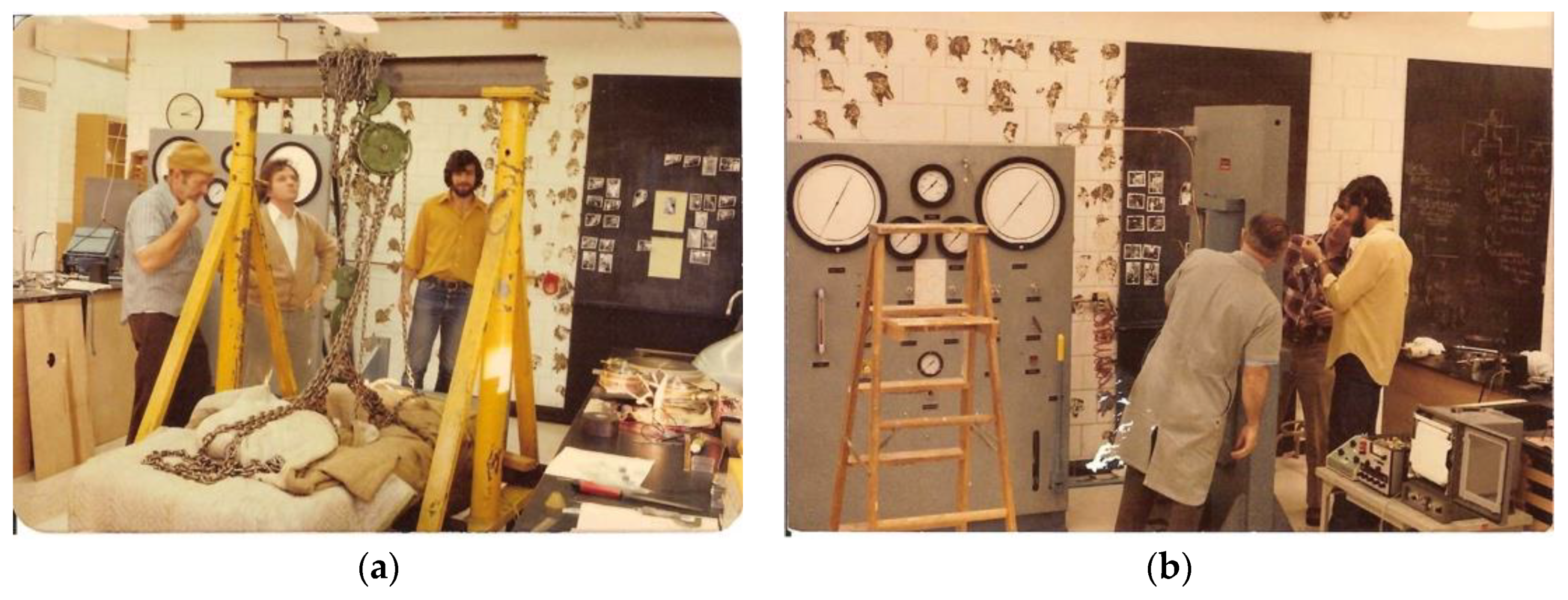
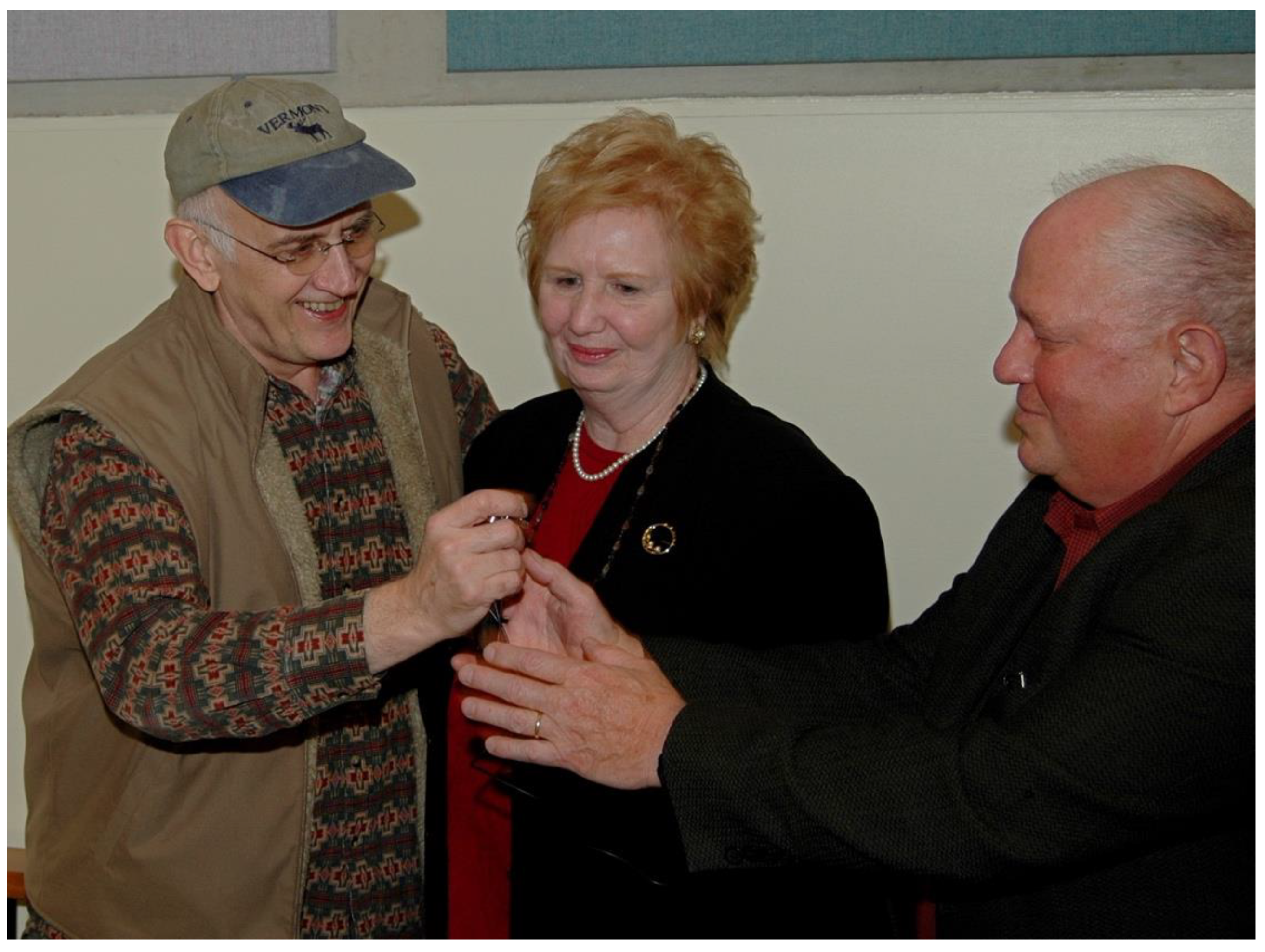
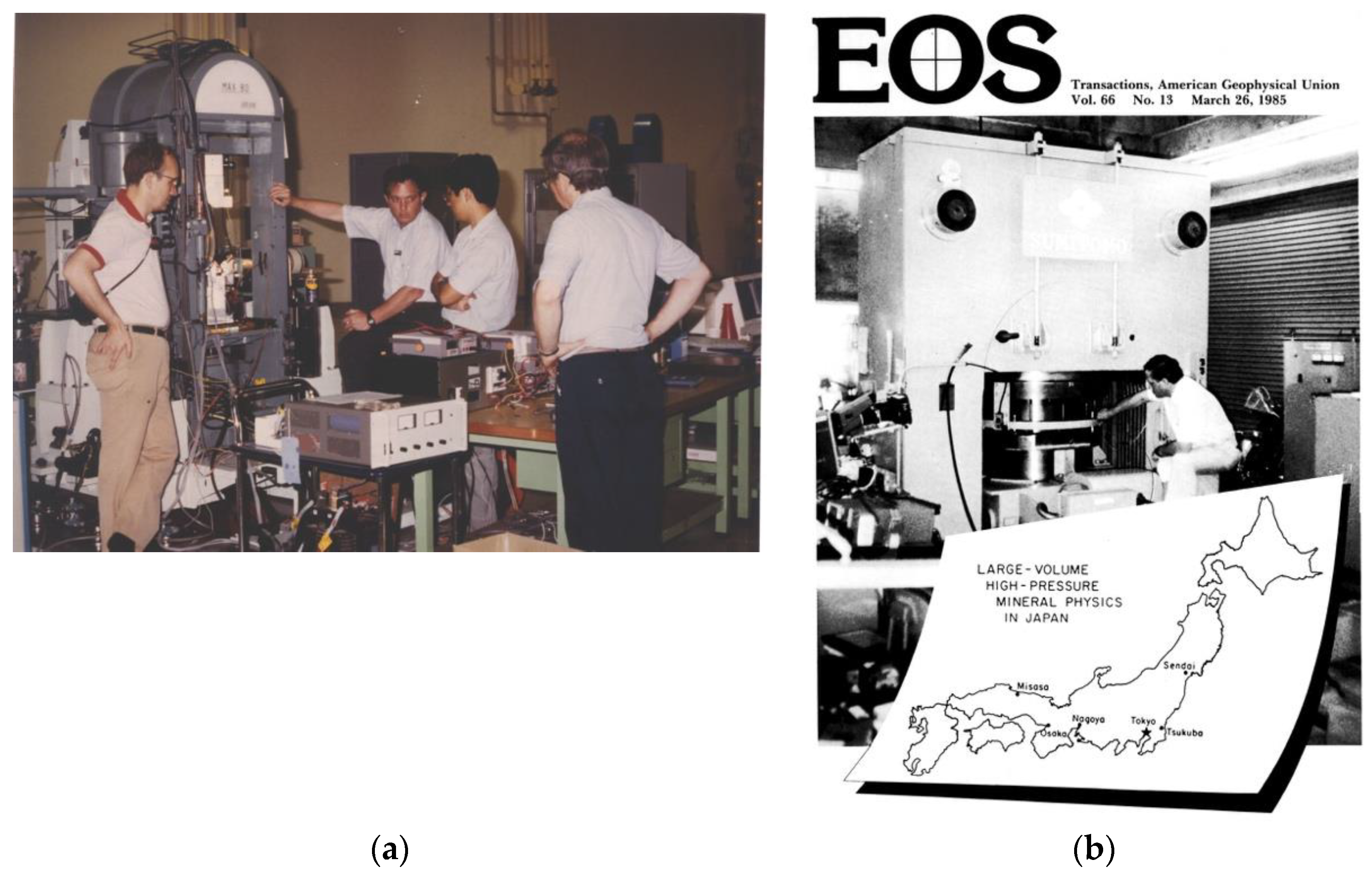





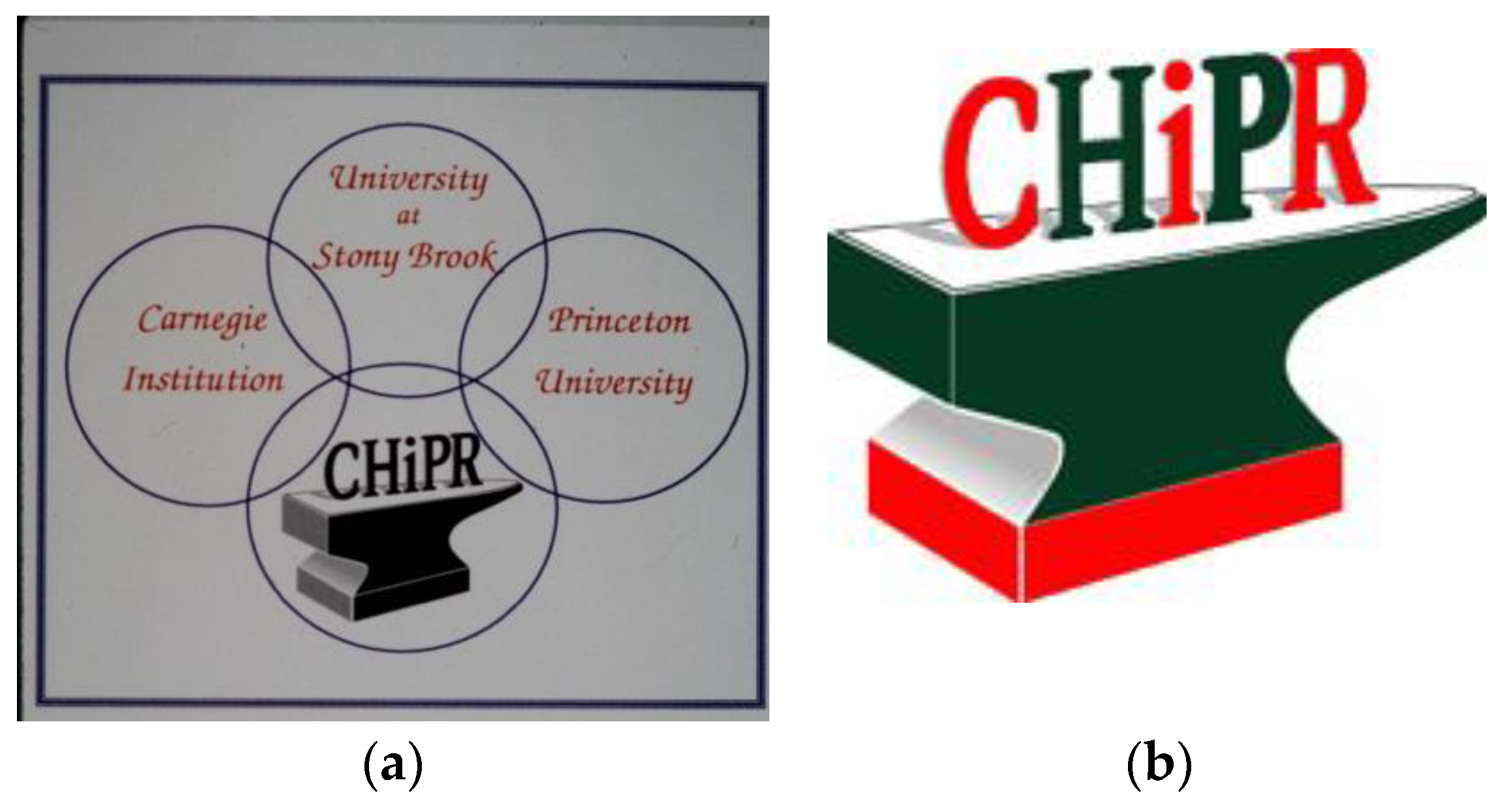
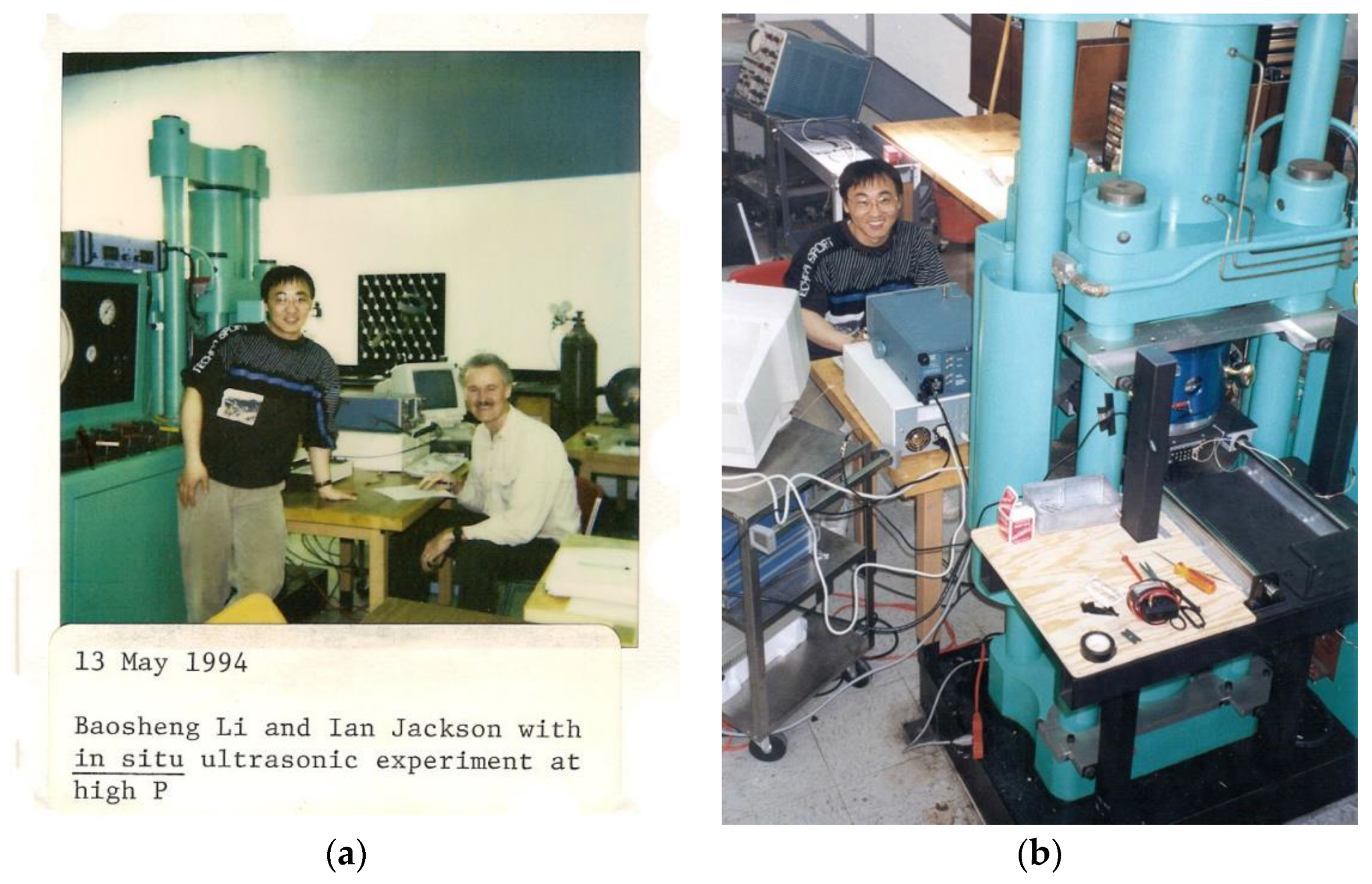

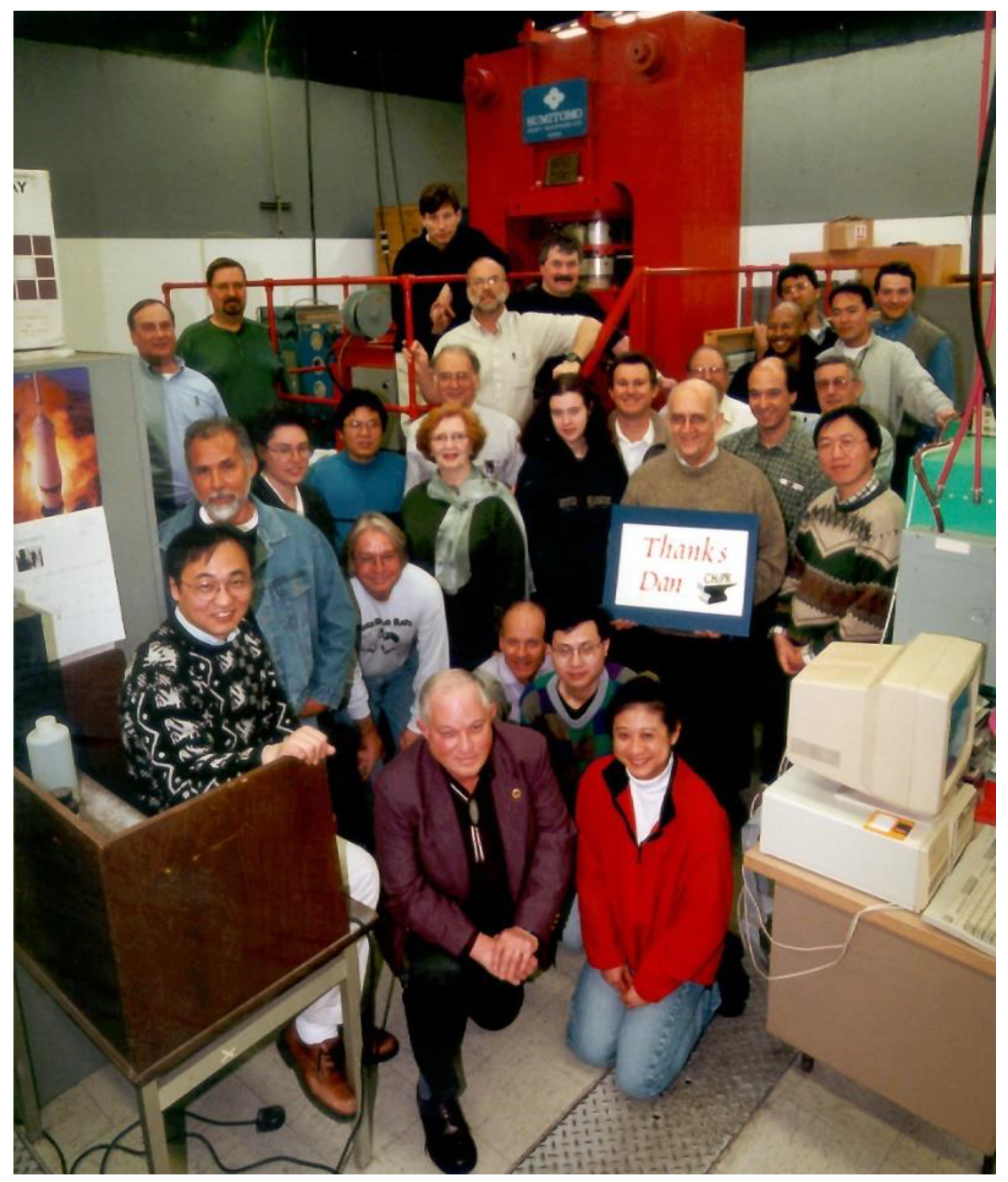
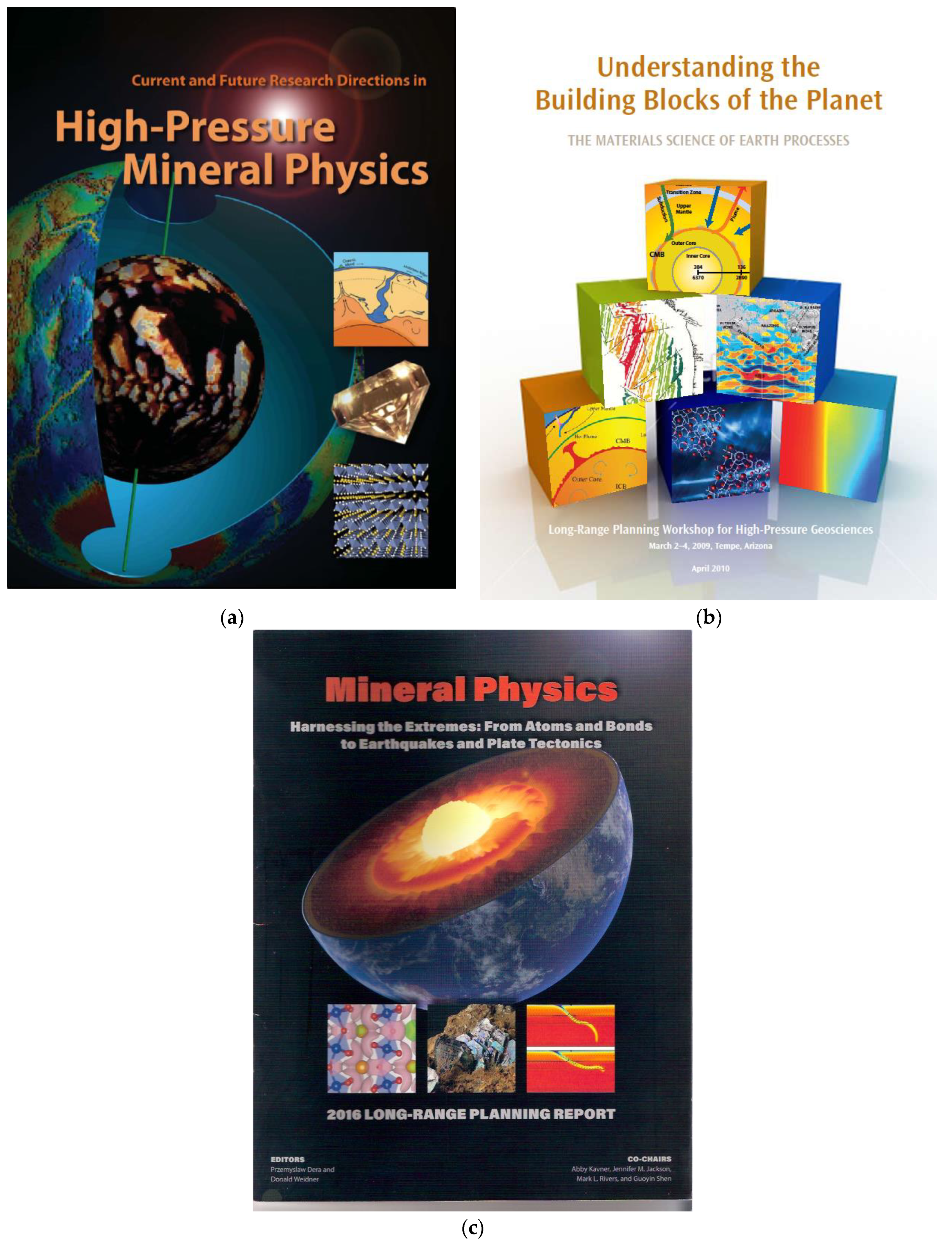
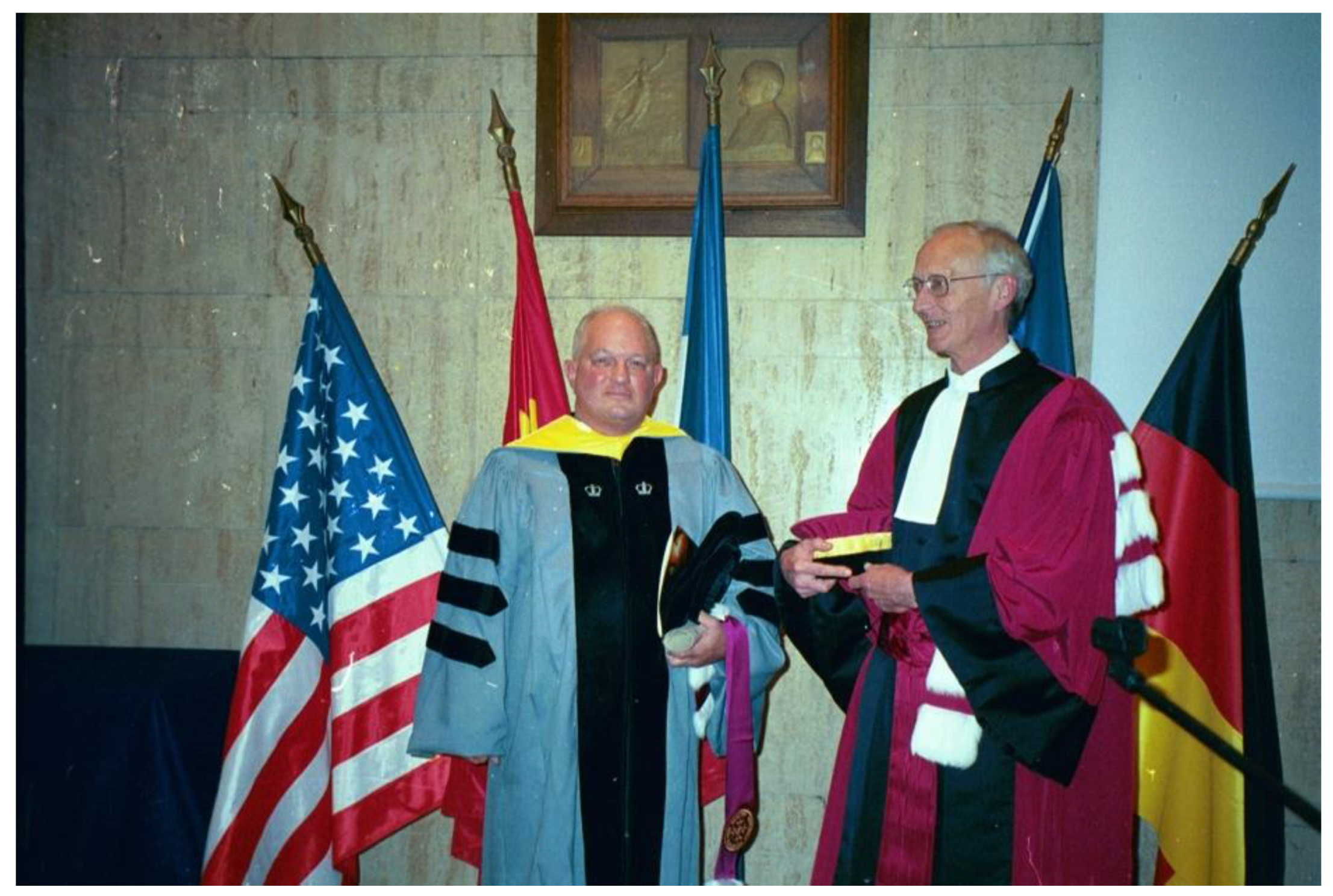
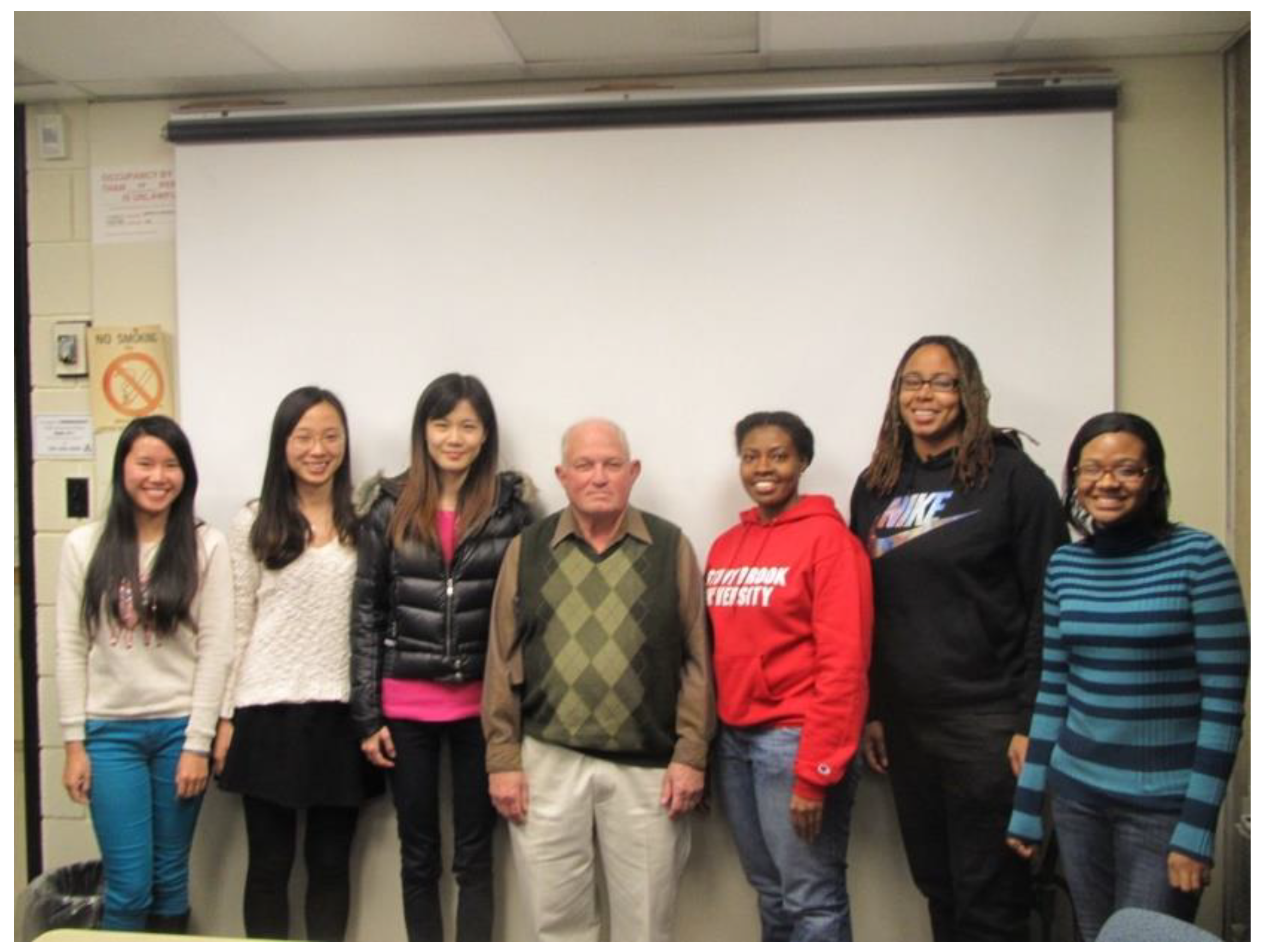
© 2019 by the author. Licensee MDPI, Basel, Switzerland. This article is an open access article distributed under the terms and conditions of the Creative Commons Attribution (CC BY) license (http://creativecommons.org/licenses/by/4.0/).
Share and Cite
Liebermann, R.C. My Career as a Mineral Physicist at Stony Brook: 1976–2019. Minerals 2019, 9, 761. https://doi.org/10.3390/min9120761
Liebermann RC. My Career as a Mineral Physicist at Stony Brook: 1976–2019. Minerals. 2019; 9(12):761. https://doi.org/10.3390/min9120761
Chicago/Turabian StyleLiebermann, Robert Cooper. 2019. "My Career as a Mineral Physicist at Stony Brook: 1976–2019" Minerals 9, no. 12: 761. https://doi.org/10.3390/min9120761
APA StyleLiebermann, R. C. (2019). My Career as a Mineral Physicist at Stony Brook: 1976–2019. Minerals, 9(12), 761. https://doi.org/10.3390/min9120761




